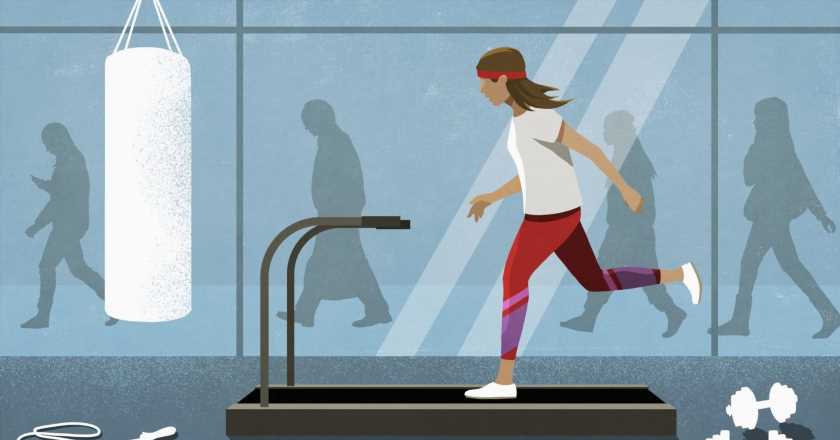
Go on any weight training Reddit thread or online forum and you’ll quickly find someone claiming that cardio “ruins” gym gains, writes Aimee Pearcy. Here’s why that’s simply not true.
If you want to get strong, build muscle and protect gym gains, you don’t start running. Right? Sure, boxers might run to improve fitness, but if weights room chat is to be believed, you’re not supposed to do too much cardio for fear of losing muscle.
Weights enthusiast Tina Clough used to be one of those anti-running gym-goers until she found herself training for Run For Heroes. In no time, she noticed that she felt both physically and mentally more powerful. “I felt great doing it and it really helped me to get stronger.”
You may also like
Fitness PSA: if you’re not making gains in the gym, your genes are probably to blame
Having taken a winter hiatus, Clough is now back running outdoors to complement her gym workouts. But for many women, no amount of sun is enough to convince them to drop their weights and pick up a pair of running shoes. Perhaps that’s partly because we naturally have lower testosterone levels than men, which means that it tends to be harder for us to build muscle tissue. Speaking to fellow gym-goers, I’ve found that it’s not that women don’t want to do cardio, it’s that they don’t believe it will help them to achieve their goals.
Spend some time on some online gym-bro forums and it won’t take you long to find people talking about this idea that cardio “kills your gains”. And as with so much online fitness content, it’s rarely backed up with solid research. According to physiotherapist and Complete Pilates director Helen O’Leary, it “is definitely a myth that is not going to affect 99.9% of the gym-going population”.
Where does this strength training myth come from?
To understand the thought process behind this myth, it’s helpful to know where it comes from. “The research that this was based on was with very high volumes of cardio and weight training, which is not how a programme would be developed in a real situation,” says O’Leary.
One of the studies that is frequently referenced is one that was carried out over 40 years ago in 1980. It revealed that doing 40 minutes of cardio six days a week alongside resistance training can reduce muscle growth when compared to resistance training alone. However, this study neglects to mention diet, which plays a key role in our capacity to build muscle and develop strength. In addition, more recent studies have shown that aerobic exercise done in moderation does not compromise muscle hypertrophy.
It turns out that cardio exercise could even help us to build muscle, as well as providing numerous other benefits that we can’t get from resistance training alone. It typically reduces blood pressure and (bad) low-density lipoprotein cholesterol levels, while increasing insulin sensitivity and levels of (good) high-density lipoprotein cholesterol.
Cardio is great for mental health and mood
Cardio can also be a great mood booster. The concept of a “runner’s high” isn’t a myth – even if it takes a little practice to experience it for yourself. Contrary to popular belief, the euphoric feeling runners experience isn’t caused by endorphins but rather happens as a result of endocannabinoid receptors in your body.
These endocannabinoids are released into the bloodstream in high quantities when we do high-intensity exercise. While research has shown that as little as 15 minutes of strength training per day can increase the level of endocannabinoids in our bloodstream, they are released in their highest quantities when we do exercise that keeps our heart rate elevated to about 70% and 80% of our maximum heart rate – such as running or cycling.
How to ensure cardio complements your strength regime
To capitalise on those feel-good effects, O’Leary suggests making your cardio sessions “more low impact so that you’re less likely to suffer from DOMS, [which can] affect your weight training session effectiveness. But you can still work the heart and lungs hard, for example, with cycling instead of running.”
But the best kind of cardio exercise, as ever, is the type that you enjoy and can stick to. Since ending her career as a professional figure skater, Gracie Page-Fozzati found herself craving an athletic and artsy outlet. During lockdown last year, her husband surprised her with a pair of roller skates, which she now uses to skate in a straight line down the Thames Path. “It’s harder than it sounds and actually a massive workout,” she says. “I want to be that 80-year-old running marathons and if I don’t lay the foundations in my 30s that’s not going to happen.”
But even if you have no desire to ever step foot on a running track, cardio can still help you to reach your fitness goals. “As physios, we would always look at the patient’s goal of training, even once they have recovered from an injury. This helps them to focus on exactly what they are trying to achieve and we can then break down what they have to do to get there,” says O’Leary.
“If increasing muscle bulk is part of the plan for them, we would still recommend including cardio for the benefits described earlier, as well as the fact it will actually allow them to tolerate increased strength sessions if their cardiovascular fitness is increased.”
For more strength training tips, visit the Strong Women Training Club.
Images: Getty
Source: Read Full Article